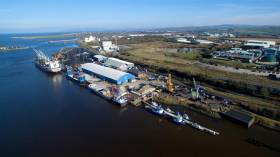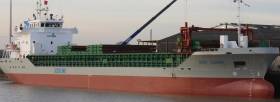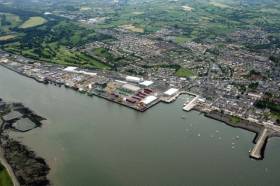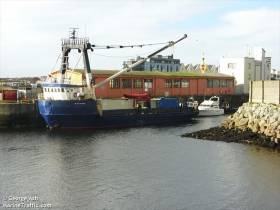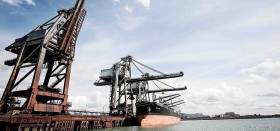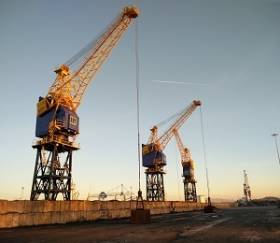Displaying items by tag: Ports & Shipping news
Shipping Review: Foggy Arklow Launch, DFDS Celebrate 150th, Brexit ‘Special Port Zones’ & Sligo Harbour Traffic Up
#ShippingReview - Jehan Ashmore reviews the shipping scene from among the following stories of recent weeks.
Particularly foggy conditions took place at the launch of Arklow's newest dry-cargo vessel, Arklow Valour in The Netherlands. This is the fourth Eco-Trader 5,150dwt ship built of 10 ‘V’ series ordered.
Ferry and freight giant, DFDS celebrated its 150th anniversary, the Danish-owned operator includes container feeder links between Ireland, Belgium and Netherlands through subsidiary DFDS Logistics.
In response to potential administrative complications from Brexit, the British Ports Association (BPA) has called for UK government to classify ports as ‘special port zones’.
Short-sea operator Scotline acquire tonnage as Scot Leader joins fleet that are regular Wicklow Port callers. Both operator and port are heavily engaged in trading timber cargo.
Arundo is one of 18 cargoships so far in 2016 that docked in Sligh Harbour an increase of 18% in traffic compared to last year.
Chris Hazzard, Ports Minister Northern Ireland says a new departmental ‘Brexit Planning Team’ has actively engaged with Lisahally (Foyle Port) London/Derry since the end of summer.
Minister's New ‘Brexit Planning Team’ In Talks With Foyle Port
#FoylePort - Chris Hazzard the Ports Minister says a new departmental ‘Brexit Planning Team’ has been actively engaging with the authorities at Lisahally since the end of the summer.
As the Derry Journal writes the Minister said talks will continue as London proceeds with the process of withdrawing from the European Union.
“In August of this year I took the decision to establish a dedicated Brexit Planning Team within my department,” Mr Hazzard revealed.
“Since its formation, the team has actively engaged with numerous key stakeholders, including the Belfast Harbour Commissioners and the British Ports Association, of which Belfast, Foyle, Warrenpoint and Larne Ports are members.
For more on what the Ports Minister had to say, the newspaper has more here.
#NewcomerShip – Short-sea operator Scotline have acquired Odertal this month and renamed as Scot Leader joined the company fleet that are regular Wicklow Port callers, writes Jehan Ashmore.
The 90m general cargoship Odertal registered in Antigua and Barbuda underwent drydocking in Hull. Works included repainting in Scotline’s house colours with the funnel aptly depicting the ‘Saltire’, the distinctive national flag of Scotland also known as St Andrew's Cross.
On completion of drydocking, the newly acquired ship emerged as Scot Leader and under the UK flagged like the rest of the nine-strong company owned fleet that includes Scot Ranger. Only a week ago today, Scot Ranger of 4,500dwt similar to that of the newcomer, was monitored by Afloat.ie bound for Warrenpoint, Co. Down on Carlingford Lough having departed Wicklow Port.
Notably in August, Wicklow Port became the first of five 'Ports of Regional Significance' to transfer to local authority control under the 2013 National Ports Policy. The most easterly port in the Republic now under Wicklow County Council, has over many years specialised in timber trade imports from Scotland and Scandinavia.
Scotline Leader is registered at Inverness from where Scotline made its first shipment in 1979 bringing logs to Bremen, Germany, before moving the route to Varberg in Sweden.
Trade in packaged timber products at Wicklow Port remains to be a major cargo for Scotline, the Rochester in Kent based operator which operates liner trade routes in north-west Europe and Scandinavia. The addition of Scot Leader which has a single box hold provides a timber-fitted capacity of 6,325 cubic metres. The new entrant originally launched as Odertal in 2007 from Bodewes shipyard is currently busy rolling out a 10 ship order for Arklow Shipping.
The Scot Leader can handle 221 TEU containers. On a related note, when writing for Inshore-Ireland (Oct.2005) about Wicklow Port Company during the height of the Celtic Tiger, the port had plans for a container load-on/load off (lo-lo) terminal. Against this backdrop the port was experiencing boom times with not just timber but also plasterboard due to the demands of the construction industry.
The container facility would have been a historic first for the harbour but the project never took off the quayside. Wicklow Port has three commercial quays.
Scot Ranger's recent call took place alongside Packet Quay which is the most commonly used berth. The other berths closer to the town are the North and South Quays that line the Leitrim River before it flows into the sea.
Brexit Ports: British Ports Association Call for Special Zones
#BrexitPorts - The British Ports Association (BPA) in response to potential administrative complications that could arise from Brexit, is calling for the UK government to classify port areas and surrounding clusters as ‘special port zones’.
As Container Management writes, BPA chairman Rodney Lunn and director Richard Ballantyne met with John Hayes, the minister of state at the Department of Transport to address concerns that Brexit could bring increased frontier and customs activities at ports.
There are concerns that these added processes could discuss cargo and logistics flows, making UK ports less competitive and adding costs to the freight industry, noted a statement from the BPA.
To tackle these issues, Ballantyne stated: “We envisage a system whereby port areas and surrounding clusters might be classified as ‘special port zones’ with fast tracked planning and licensing systems.
“Such zones could safeguard against restrictive environmental designations, which can often limit port growth and development,” he added.
Ballantyne also highlighted his wish that government activity at UK borders do not disrupt freight and passenger gateways.
In any case, the specific conditions of Britain’s post-Brexit trading relationship with the European Union (EU) will only become known following the UK government’s triggering of Article 50 of the Lisbon Treaty and a subsequent negotiation.
Danish Shipping Giant With Irish Services DFDS Celebrates 150th Anniversary
#DFDS@150th - DFDS celebrates its 150th anniversary today, the giant Danish ferry and freight operator is northern Europe’s largest integrated shipping and logistics company which includes container operations connecting Ireland, writes Jehan Ashmore.
On 11 December 1866, the famous Danish industrialist Carl Frederik Tietgen formed Det Forende Dampskibs-Selskab (The United Steamship Company) DFDS, following the merger of three of the nation’s largest steamship lines of the day. DFDS became a domestic and international shipping company, carrying both goods and passengers throughout the North Sea and the Baltic, later expanding to the Mediterranean. For decades, DFDS also sailed routes to the Americas, but closed in 1935 albeit a brief return to the US with a New York-Bahamas-Miami service in the early 1980's.
The DFDS Group currently has a network of around 30 routes and 50 passenger ships and freight ships involving ports in Ireland, the UK, France, Holland, Germany, Denmark, Norway, Sweden and the Baltic region. Afloat in the summer reported on the North Sea Tall Ships Race 'Parade of Sail' hosted by the Port of Blyth where DFDS Seaways cruiseferry Princess Seaways made a special excursion for spectators to view the ‘Parade of Sail’.
A sister, King Seaways (see photo above) also operates the Newcastle-Amsterdam (Ijmuiden) route. Beforehand she was an Ireland-France serving ferry, Val de Loire of Brittany Ferries which was introduced in 1993. Prior to entering service the bow was rebuilt to cope with notably notorious Bay of Biscay weather conditions when also operating UK-Spain services and a France-UK link.
A slanted forward superstructure was also added. Having made a crossing from Ireland this area revealed an internal observation zone. While on the deck directly above this too was a viewing area but exposed to the open elements.
One of the Danish shipping group's subsidiaries, DFDS Logistics operates container services connecting Ireland, Belgium and The Netherlands. This involves a network of ports: Dublin, Cork, Waterford (see previous coverage) and Belfast with European ports of Antwerp and Rotterdam.
A decade ago in 2006, DFDS had acquired Norfolk Line Containers BV, the Dutch operator having previously introduced a pair of newbuild sisters given names to reflect the geographic regions they served. They were Maerk Westland and Maersk Waterford which was aptly named at the Port of Waterford (Belview). An opportunity arose to board the brand new vessel was taken months later at its namesake port where Irish owned former Bell Lines were once the 'Kings' of a similar service.
The south-east port is Ireland's nearest to that of mainland continental Europe, noting in the early stages a joint Norfolkline / Marline service saw en-route calls via Cherbourg.
Four years after DFDS acquired the Dutch container subsidiary, the Danes for first time entered the Irish Sea ferry marketplace in 2010. This arose following DFDS largest and most important decision in its history by acquiring the remaining businesses of Norfolkline, from another yet even larger Danish clongomerate, AP Møller-Maersk. These pale-blue hulled ships are very much a familiar sight as they operate worldwide.
The purchase transformed the DFDS Group into a major shipping company. Albeit the presence of the ‘Maltese’ cross symbol synonymous with the company would only be around a mere six months.
Another Scandinavian shipping heavyweight, as Afloat reported almost six years ago was Stena's £40m acquisition deal of DFDS Irish Sea's unprofitable routes over the winter of 2010/2011. The Swedish-based ferry operator took over freight-only Belfast-Heysham route along with Belfast-(Birkenhead) Liverpool but not the closed Dublin-Heysham /Liverpool links.
It was on the Dublin route that sisters Dublin Seaways and Liverpool Seaways served, however the ropax pair are now operating far away from the Irish Sea.
Dublin Seaways is serving in the southern hemisphere for operator Bluebridge linking New Zealand’s north and south islands. The Cook Strait service is where other former Irish Sea ferries operate.
As for Liverpool Seaways (for photo at Dublin Port, scroll down page) she surprisingly still retains the Mersey link name. In addition she remains with DFDS in Scandinavia plying the Baltic Sea between Kapellskär, Sweden and Paldiski, Estonia.
Aran Islands Snapshot: Galway Port Based Freight Operator Serves Islanders Essential Daily Needs
#AranIslands – As talks today to resolve the ongoing Aran Islands ferries dispute over passenger levies with Galway County Council, Afloat.ie takes a snapshot of a separate but freight-only operator providing vital supplies to islanders, writes Jehan Ashmore.
The affected Island Ferries Teoranta passenger ferry service: Rossaveel-Kilronan on Inis Mór, the largest of the Oileán Árann / Aran Islands was due to end last week, however, as Afloat previously covered the service is still operating as “a gesture of goodwill to the Islanders”.The ferry service will remain in place until 17 January 2017 however this date remains under review subject to how the discussions progress on the council-imposed passenger levy for the non-PSO ferry route to Inis Mór. In recent years this route has been subject to a sharp rise in fares.
As for the freight-only operator, Lasta Mara Teoranta, the company since 2005 has the Government contract to carry cargo not just serving Inishmor but also Inis Meain and Inis Oirr. These services are an essential lifeline for islanders. Lasta Mara is the main cargo company serving the Aran Islands by operating from the mainland based in Galway Port using MV Bláth na Mara (1983/330grt).
All the daily needs of the islanders are carried in containers on board Bláth na Mara from food stuffs (chill and frozen), to household goods, furniture and fuel. As for larger items such as vehicles and old fashioned form of transport that includes horses (given the tourist jaunting carts) and other lifestock are also conveyed on the coastal freighter.
A ‘roll-on roll-off’ i.e. ro-ro service from Rossaveel, Connemara is also provided by Lasta Mara using the MV Chateau-Thierry (see report photo) a former US Army tank landing craft. As previously reported the vessel brought emergency electrical generators due to power-cuts earlier this year.
Otherwise Chateau-Thierry's routine heavy goods cargoes are in the form of trucks, diggers and heavy plant and machinery. Such construction related vehicles were transported by Chateau Thierry from the mainland to Kilronan Harbour during the building of the new harbour. These vehicles rolled off the bow loading ramp onto the sandy beach at Kilronan, the capital of the Aran Islands.
The costs to pay for Kilronan's new outer harbour (see engineering award) are derived through the passenger levies which are at centre stage of the ferry dispute.
As for the cargo service in order to maintain all perishable cargoes remain frozen before departing Galway Port, the outer pier is where a warehouse is equipped adjacent to where Bláth na Mara berths. The Galway-Aran Islands routes should also be noted as Ireland’s longest distance domestic (island serving) commercial cargo service.
It is on such trading routes that the old traditional joint passenger /cargo service had run up to 1988. This was carried out by the State owned Coras Iompair Eireann (CIE) group’s vessel Naomh Éanna.
The veteran vessel built by Dublin Liffey Drydock Company in 1958 ran on the route for four decades. Since the service closed Naomh Eanna has remained languishing in the capital’s Grand Canal Dock Basin. In recent years she was transferred to a disused graving dock having been saved from scrapping. Against this backdrop there have been plans to restore the historic Irish built ship.
Marine Money London Forum Returns to UK's Capital of Shipping Finance
#MarineMoney - Four days after the inauguration of the new US President in early 2017, Marine Money together with Anchor Sponsor KMARIN/KOTAM will host the 8th Annual Marine Money London Forum on Wednesday 25th January.
Amongst the Forum topics will be of course Brexit, the new US President and the impact on shipping. All in which will be discussed in the ballroom of The Dorchester Hotel on Park Lane, Mayfair. This will be the first Marine Money Ship Finance event of 2017 and its platform held in the UK capital is a major centre for shipping and finance, broking, legal and insurance.
London's location between the capital of Wall Street and the cargo demand of the Far East, is the place that shipowners from near and far call a home away from home. At the London conference leading shipping companies and financiers will meet to discuss challenge, risk, opportunity and investment - how to survive the downturn and prepare for the long awaited improved shipping market.
From buying dry bulk at rock bottom: structuring long term investments with Chinese financial leasing; analysing markets and assessing investment opportunities; finding finance from San Francisco, London and Shanghai.
The Marine Money London agenda 2017 will cover the red hot topics of the current market. To find the Marine Money Preliminary Programme click here.
Registration forms to attend Marine Money London Forum can be accessed here and for more information contact: Mia Jensen at [email protected]
Tata Commits to Saving Steel Port Talbot’s Future
#SteelPort - Upgrading infrastructure work at ABP’s port of Newport, south Wales involved an engineering firm from Port Talbot where also located is the giant steelworks of Tata Steel whose 4,000 strong workforce recieved much welcomed news yesterday, writes Jehan Ashmore.
The Welsh workforce were given a commitment to job security and across Tata’s other UK plants according to BBC News. It could bring an end to eight months of uncertainty for thousands of workers who faced losing their jobs when Tata's UK business was put up for sale. Tata held talks with unions yesterday (Wednesday) and said it was "an important step forward" for its future in the UK. But workers still have to agree to pensions changes and will be balloted.
Almost 7,000 people are employed by Tata Steel across Wales, including those in Port Talbot, to read more click here. The port located between Swansea and Barry (see former Seaspeed Ferries) along with Cardiff and Newport make up ABP South Wales five ports handling more than 13 million tonnes of cargo annually. In total Associated British Ports group has 21 ports throughout the UK.
It is at this Bristol Channel port one of only a few harbours in the UK that Port Talbot is capable of handling cape-size vessels of up to 170,000dwt. The two 300m long berth of the deepwater jetty built in the 1970’s is predominantly for importing coking coal, minerals and ores to the Tata plant which is Indian owned.
On the other side of the Celtic Sea, the last such steel works in the Republic was the Irish Steel plant in Cork Harbour. The factory on Haulbowline Island was on a site of a former 1869 dockyard neighbouring the Naval Service Base. The plant’s last owners ISPAT /Irish Steel, also an Indian owned business had a workforce of 400 until closing in 2001 with accumulated losses of £10m.
A legacy of such heavy industry remains as Afloat reported in January of the then Marine Minister Simon Coveney announcment of a two-and-a-half-year programme of core remediation works during a meeting with the Haulbowline Remediation Project Stakeholders Group.
Remediation of the contaminated waste site is to be completed by mid-2018. This followed a Government decision to provide a total of €61 million to remediate the location on a “whole of Island basis”, incorporating both the east and south tips and including a ground level remediation of the former factory site.
The eyesore of the spoil site on the eastern end of Haulbowline Island over the years could easily be seen by tourists on board inbound Brittany Ferries Roscoff-Cork seasonal-only sailings.
Flagship Pont-Aven whose environmental credentials consist of funnel sulphur emission ‘scrubber’ technology which was installed before this season. The 'green' measures were taken so to comply with an EU Directive on Sulphur Emissions.
The Ireland-France seasonal connection has been extended over the years with sailings running up to early November. Sailings on the continental service are to resume in April 2017.
#Cranes&Cruises – Two ports in south Wales operated by Associated British Ports (ABP) have invested over £2.8 million in the refurbishment of five cranes at Newport and Swansea, writes Jehan Ashmore.
The work which took 14 months to improve operational efficiency and extend the lifespan of the cranes was carried out by Port Talbot based engineering company, Celtic Engineering. Among the products to be handled by the cranes are coal, aggregates, forest products and steel. The refurbishment also allowed for increased handling efficiency when loading and discharging vessels.
Afloat.ie has also been researching UK operator Cruise & Maritime Voyages (CMV) whose 1,250 passenger capacity flagship Magellan is to offer a direct departure from Newport located to the east of Cardiff. Cruise-goers in season 2017 can take a two-night Dublin Mini-Cruise in June or remain on the 46,000 gross tonnage vessel as part of a longer 11 nights Fjordland Splendour & Dublin Cruise. More on Magellan but that of CMV's move to offer direct cruises from the Irish capital will appear on our Cruise Liners news.
Further along the coast beyond the Walsh capital to the west is Swansea where the investment programme by ABP to upgrade cranes will be complemented by a new Mantsinen Hydraulic Crane due to be installed at the port next month. The crane forms part of a £6 million deal that will see five new cranes delivered across the UK port group’s network of 21 ports.
Swansea has strong Irish maritime connections given the former Swansea-Cork Ferries service that was followed by last incumbent, Fastnet Line that ceased operations in 2011. In more recent times at Swansea Dry Docks the shiprepairer and recycling facility was last winter the recipient of Cork based Mainport Group’s disposed seismic support vessel Mainport Ash.
IMDO Review: Brexit Raises Foyle Dispute, Shiprepairs Boosts Retrofits & Hapag-Lloyd Acquire UASC
#IMDOreview: The Irish Maritime Development Office (IMDO) Weekly Market Review which is produced in-house returns this week with coverage of domestic and global shipping news.
Irish Maritime News: Brexit has revived a dormant territorial dispute between Britain and the Republic of Ireland over the ownership of Lough Foyle as also reported on Afloat.ie. Lough Foyle in Derry and Carlingford Lough, between Counties Louth and Down, are both matters of dispute between Dublin and London.
Ship repair market could see huge boost on retrofits: A series of new regulations, most notably the Ballast Water Management Convention, as well as the recent cap on the use of sulphur fuels, is bound to lead to increased retrofits; since shipowners will gradually look to keep their vessels compliant.
EU Commission approves container liner shipping merger: The European Commission has cleared under the EU Merger Regulation the proposed acquisition of United Arab Shipping Company (“UASC”) by Hapag-Lloyd of Germany, subject to conditions. Both companies operate in the container liner shipping sector.
For more stories of this edition which is available here in addition to Afloat's dedicated Ports & Shipping news coverage.



























